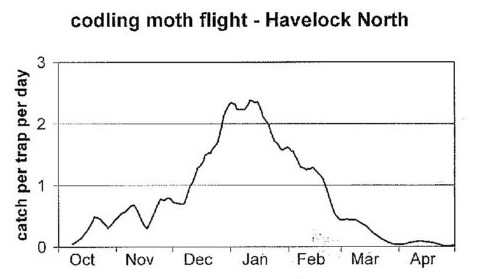Use of this codling moth pheromone trap
The codling moth pheromone trap is a monitoring tool for capturing male codling moths and is an indicator as to the population levels of codling moth in your area. It should be placed in the tree early in the season, about the month of October to November. It can be checked once a week and the number of moths present can be counted, recorded and removed from the sticky base. It will show you when moths are present and the level of the population. Once you decide that the population is at a level that requires action, a spray (conventional or organic) can be applied within 1-2 weeks to ensure the spray is most effective.
In this way, the trap is your indicator of the codling moth population level, determined the optimum time to apply any spray, and helps reduce the number of sprays required overall. One trap is all that is required for a home garden location. (~1/4 acre)
PLEASE NOTE: The sticky base and pheromone lure (pherocap) should be replaced every 6 weeks.
Life Cycle Information
Codling moth is the key pest of pipfruit as it targets the fruit directly and has the potential to damage a large proportion of the crop in untreated situations. Codling moth prefers apple, but also attacks pear and walnut.
Codling moth overwinter as a fifth instar larvae (caterpillars) in a cocoon under bark, in cracks of in dry detritus under the tree. The overwintering stage often experiences the greatest mortality from factors such as waxeyes (silvereyes) feeding and fungi that infect insects. However, there are still potentially enough larvae pupating and emerging as adults to inflict significant fruit damage.
The larva pupates in it’s cocoon and adults begin to emerge in early to mid-October, peak emergence is in early to mid-December.
Adults mate, often in the tops of trees, and then the female will fly around laying single eggs within 10cm of fruit. A single mated female has the potential to damage 40-50 fruit. Eggs are difficult to find, but are about 2mm in diameter. Eggs can be exposed to some insecticides (oils).
Eggs hatch 7-10 days later, which is typically petal-fall at the earliest. The newly hatched larvae then have to locate a fruit. It is this stage where it is vulnerable to predation and microbial insecticide (codling moth granulosis virus, CMGV: ‘Madex’) exposure. After microbial insecticide exposure, newly hatched larvae often die just after entering the fruit, leaving a codling moth ‘sting’.
Once inside the fruit the insect is relatively safe and will burrow towards the pip cavity and consume the seeds. During this time fruit can abort from the tree, giving a false indication of the level of codling moth damage at harvest. The larva often exits the fruit by a separate hole (typically the hole without frass) and finds a site to cocoon.
Typically there is only one extended generation, but some individuals will not diapause and emerge in late summer to mate and lay a second generation of eggs/larvae. Few of these second-generation larvae complete development before fruit is harvested.
Males locate females using sensitive receptors on their antenna, which can detect small amounts of pheromone released by the female. When males detect pheromone they will often start wing fanning to draw more air over their antennae. If more is detected they often start to fly up-wind in a zig-zag fashion keeping the signal as strong as possible, until they locate the female and mate. Moths can mate more than once.
For codling moth female calling and mating only occur for a couple of hours after dusk and on rare occasions just prior to dawn. Codling moth do not fly in temperatures below 12°C. Moths cannot fly in high wind conditions, although localised flying may be possible within the shelter of the trees.

The above codling moth adult flight activity should only be used as a guide, as the number of moths in your area may differ, depending on your location.
